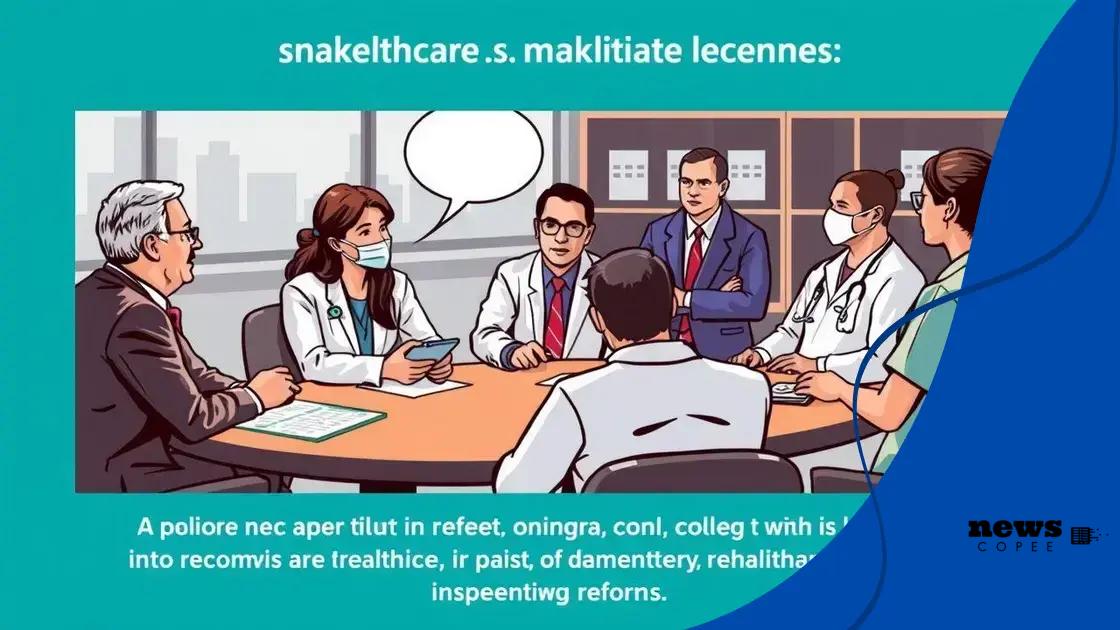Healthcare cost-sharing reforms enacted: what you need to know

Healthcare cost-sharing reforms enhance affordability and access by reducing out-of-pocket costs, increasing transparency, and promoting personalized financing options tailored to individual patient needs.
Healthcare cost-sharing reforms enacted are changing the landscape of medical expenses, making it essential for everyone to grasp their implications. Ever wondered how these changes might affect your wallet or access to care? Let’s dive in!
Understanding healthcare cost-sharing reforms
Understanding healthcare cost-sharing reforms is essential in today’s rapidly changing healthcare landscape. These reforms aim to improve affordability and access to care for patients. By exploring the key elements of these reforms, we can better grasp their importance and application in our lives.
What Are Cost-Sharing Reforms?
Cost-sharing reforms involve changes in how healthcare expenses are divided between providers and patients. This system determines the amount individuals pay out-of-pocket when receiving medical services. The reforms aim to reduce financial barriers, making healthcare more accessible for everyone.
Key Benefits of Cost-Sharing Reforms
By implementing these reforms, several advantages emerge:
- Increased Access: Lower out-of-pocket costs allow more individuals to seek medical attention without financial strain.
- Improved Health Outcomes: When patients can afford care, they are more likely to receive timely treatment, leading to better health overall.
- Financial Protection: Reforms can help shield patients from unexpected medical expenses, minimizing the chance of medical debt.
Furthermore, these reforms encourage preventive care. By decreasing costs for routine check-ups and screenings, patients are more likely to prioritize health maintenance rather than waiting until problems escalate. Health coverage becomes a pathway to wellness rather than a burden.
Challenges in Implementation
Despite the numerous benefits, challenges also exist in the implementation of cost-sharing reforms. Insurance companies may resist changes that reduce their profits. Additionally, regulatory hurdles can hinder effective reform deployment. It’s crucial to continuously evaluate these processes, ensuring reforms meet their intended goals while adapting to new challenges.
The evolving nature of healthcare requires that we all stay informed about initiatives and reforms affecting our access to care. Understanding how cost-sharing works will help empower consumers to make informed decisions regarding their healthcare options.
Key benefits of recent reforms
When discussing the key benefits of recent reforms in healthcare cost-sharing, it’s important to recognize how these changes are shaping the experience for patients. These reforms not only enhance financial protection but also promote better health outcomes for communities.
Accessibility and Affordability
One of the foremost advantages of these reforms is the increase in accessibility and affordability of healthcare. Patients can avail themselves of necessary medical services without the burden of high out-of-pocket costs. This shift encourages individuals to seek preventive care, leading to healthier populations.
Improved Health Outcomes
With a focus on lowering costs, recent reforms have shown a direct impact on overall health outcomes. Fewer people delay seeking treatment because of cost concerns. This proactive approach helps reduce complications from chronic conditions, contributing to a more productive society.
- Reduction in Delayed Care: Patients receive timely treatment, preventing small issues from becoming serious health problems.
- Encouragement of Preventive Services: Regular screenings and check-ups become more commonplace, shielding patients from serious illnesses.
- Better Management of Chronic Conditions: Patients can afford necessary medications and follow-up visits, improving their quality of life.
Additionally, these reforms foster a sense of financial security among patients. When individuals know that their healthcare costs are manageable, they are more likely to pursue a holistic approach to their health. It changes the perspective from reactive care to proactive health management.
Economic Vitality
Another critical benefit of the reforms is their contribution to economic vitality. Healthier individuals mean a more productive workforce, which can lead to higher economic growth. Furthermore, by addressing healthcare costs, families can allocate their budgets more effectively towards other essential needs and savings.
Also, these reforms encourage competition among healthcare providers. With more patients able to access services thanks to lower costs, healthcare organizations are motivated to improve the quality of care they provide. This competition often results in better patient experiences and outcomes overall.
Challenges faced in implementing reforms

Implementing healthcare cost-sharing reforms comes with a variety of challenges that can hinder progress. Understanding these obstacles is essential for ensuring that reforms achieve their intended goals.
Regulatory Hurdles
One major challenge is navigating the complex regulatory landscape. Many reforms require approval from multiple governing bodies, which can slow down the implementation process. Furthermore, variations in state laws add layers of difficulty, making it hard for providers to comply with new regulations.
Resistance from Stakeholders
Another significant challenge arises from resistance among stakeholders. This includes insurance companies, healthcare providers, and even patients who may be hesitant about changes. Some providers worry about potential revenue losses, while others may face difficulties in adapting to new systems and processes.
- Insurance Companies: They might oppose reforms that reduce their profit margins or alter reimbursement rates.
- Providers: Some healthcare providers fear the financial impact of implementing new cost-sharing structures.
- Patients: Initial confusion can lead to resistance as patients navigate changes to their coverage.
Additionally, effective communication is crucial during the implementation phase. Without clear information, patients may misunderstand their options, leading to frustration or avoidance of necessary care. Training and resources for healthcare workers are essential to ensure they understand the reforms and can effectively assist patients.
Financial Constraints
Funding is another hurdle many face in implementing these reforms. Limited financial resources can curtail the development of new systems needed to support cost-sharing initiatives. Moreover, organizations may struggle to find the initial investment required to modify technology and processes for better service delivery.
Ultimately, overcoming these challenges requires collaboration among all involved parties. Understanding stakeholders’ concerns and working collectively towards solutions can help pave the way for successful reforms. Addressing these obstacles will be critical in ensuring that healthcare cost-sharing reforms truly benefit the populations they are intended to serve.
Consumer response to cost-sharing changes
The consumer response to cost-sharing changes is vital in understanding how effectively these reforms are being received. As these changes impact how individuals access and pay for healthcare, consumer perspectives can provide valuable insights.
Awareness and Understanding
Awareness is the first step for consumers. Many individuals need time to learn about the new cost-sharing structures. As reforms roll out, education becomes essential. Consumers who understand the changes are more likely to adapt positively. However, some may struggle to grasp how these adjustments affect their out-of-pocket costs.
Initial Reactions
Initial consumer reactions can vary widely. Some consumers may welcome the reforms, appreciating lower costs for medical services. Others might feel uncertain about how their healthcare plans will change, leading to confusion. Clear communication from healthcare providers and insurance companies is crucial during this period.
- Positive Responses: Many consumers might find that they can now afford necessary treatments, leading to increased satisfaction with their healthcare.
- Concerns: Others may worry about hidden fees or unexpected costs, leading to skepticism about the reforms.
- Increased Engagement: As consumers learn more, they may take a more active role in managing their health and healthcare expenses.
Moreover, the transition period after reforms can create uncertainty. Some consumers may initially resist changes simply due to discomfort with the unknown. This resistance can be addressed through ongoing communication from healthcare providers and organizations. Engaging consumers through workshops, webinars, and personal outreach can significantly improve their understanding and response.
Long-Term Adaptation
Over time, as consumers experience the impact of reforms, their responses may evolve. Positive experiences can lead to increased trust in the healthcare system. Conversely, lingering doubts and negative experiences can foster skepticism. Therefore, it is essential for organizations to maintain open lines of communication and provide continuous support.
Consistent follow-ups and feedback mechanisms can also help organizations understand consumer sentiments and adapt accordingly. By prioritizing consumer education and engagement, the healthcare industry can better navigate the evolving landscape of cost-sharing reforms.
Future trends in healthcare cost-sharing
Future trends in healthcare cost-sharing are essential to consider as the healthcare landscape continues to evolve. With emerging technologies and changing regulations, we can expect significant shifts in how healthcare expenses are shared among insurers, providers, and patients.
Increased Transparency
One notable trend is the demand for increased transparency in cost-sharing structures. Patients are becoming more aware of their financial responsibilities before receiving care. This shift encourages healthcare organizations to provide clear information about costs and payment options upfront. When patients know what to expect, they can make better healthcare decisions.
Personalized Healthcare Financing
Another future trend is the move toward personalized healthcare financing. Insurers are beginning to offer customized plans that cater to individual patient needs. This could mean more tailored cost-sharing models based on a person’s health status, lifestyle, and financial situation. Such personalized approaches allow consumers to find options that make healthcare more affordable.
- Behavior-Based Discounts: Insurers might provide discounts for patients who engage in healthy behaviors.
- Flexible Payment Plans: More options for paying medical bills over time will likely emerge, making it easier for patients to manage expenses.
- Data-Driven Decisions: Utilizing healthcare data will help insurers assess risks and adjust plans accordingly.
Technological advancements are also playing a crucial role in shaping the future of cost-sharing. For example, mobile applications and online platforms can help patients track their expenses and understand their share of costs. This ease of access to information empowers consumers and encourages them to take charge of their health spending.
Integration of Value-Based Care
Moreover, the integration of value-based care is set to influence cost-sharing trends. Rather than focusing solely on the volume of services provided, the healthcare system will increasingly emphasize the quality of care and patient outcomes. As this paradigm shifts, cost-sharing structures may be tied more closely to the value delivered to patients.
Healthcare providers might begin to receive incentives based on patient satisfaction and health improvements, aligning financial incentives with better patient care. This shift could ultimately lead to a more sustainable healthcare system, where costs are shared more equitably based on the quality of services rendered.
In summary, healthcare cost-sharing reforms are reshaping how costs are shared among consumers, providers, and insurers. As we look towards the future, transparency, personalized financing, and value-based care will play crucial roles in making healthcare accessible and affordable. Understanding these trends helps consumers navigate their choices confidently. By staying informed, patients can better manage their healthcare expenses and improve their overall health experiences.
FAQ – Frequently Asked Questions About Healthcare Cost-Sharing Reforms
What are healthcare cost-sharing reforms?
Healthcare cost-sharing reforms are changes in how costs are divided between patients and their insurance providers, aimed at making healthcare more affordable.
How do these reforms improve access to healthcare?
By lowering out-of-pocket costs and increasing transparency, these reforms help patients seek necessary medical care without financial barriers.
What role does technology play in these reforms?
Technology enhances accessibility to cost information, allowing patients to make informed choices about their healthcare options and expenses.
How can consumers adapt to changes in cost-sharing?
Consumers can stay informed by seeking resources and support from healthcare providers, making sure they understand their coverage and options.
